Diatomaceous Earth Filtration of Cyanide Leach Liquors
In many instances, Diatomaceous Earth (DE) filtration could be considered a relatively recent technology. In the late 1800’s there were many references to the use of DE in small scale filtrations and in most instances these were laboratory curiosities. The use of DE in the sugar industry was proposed in the 1880’s, but this was […]
Increase Plant Throughput by Mill Expansion
Shortly after start-up, it was apparent that it would be difficult to obtain the plant design throughput. The ore sample that had been used for grinding test work was found to be much softer than that of the orebody in depth. This had led the designers to design without a crushing stage and to designate […]
Chalcopyrite Leaching by Thermophilic Bacteria

Research in recent years has been directed toward seeking methods of metal extraction which are less labor and energy intensive, less costly in capital investment and are less insulting to the environment. Chemical metallurgy offers much toward meeting these criteria. Hydrometallurgy offers innovations in copper dump leaching, new developments in in-situ leaching of copper and […]
ARSENIC IN GOLD LEACHING
What happens to arsenic during cyanidation depends what form it is in; Stibnite, orpiment, arsenopyrite, realgar. If arsenic is present, regardless of what form, solubility increases with higher pH. Environmentally; during or after detox, the arsenic can be precipitated via ferric sulphate leaching to produce the highly insoluble ferric arsenates which will settle, sometime requires […]
Effect of Silver on Chlorination & Bromination of Gold
When dry chlorine gas is made to act in the cold upon finely- divided gold, it converts the latter with evolution of heat into auro-auric chloride, Au2Cl4, a hard, dark-red, hygroscopic salt. Moisture splits this salt into aurous and auric chloride, Au2Cl4 = AuCl + AuCl3 ; treatment with water converts it into auric chloride […]
Assaying Zinc Box Residues in Cyanide Leach Process
Several methods, both wet and dry, for the assay of zinc-box residues from the cyanide process, have been described in recent years, and each of them has been claimed to be superior to all others. A paper, entitled “Assay of Zinc Precipitates,” was published in the School of Mines Quarterly to the purport that the […]
LIX 64N
LIX 64N Reagent is a water insoluble mixture of substituted oximes, which form water insoluble complexes with metallic cations, principally copper. Chemical Reactions LIX 64N Reagent is a hydrogen ion donor, and its chemical reactions when used as a copper extractant may be compared to an ion exchange resin system operating on a hydrogen ion […]
SX Solvent Extraction Equipment – Process Function
Mixer Settler The Mixer-Settlers are of the pump-mixer type in which the Mixer Impellers, in addition to mixing the process liquors, also provide the pumping head necessary to transfer them between stages. The variable speed Impellers can be used either with, or without, spoiler blades, the design of which is such that when fitted the […]
SX Solvent Extraction of Metals: A Design Manual
Definition of Solvent Extraction: The unit operation “solvent extraction” is applied in many industries, and has several different forms. For instance, for the recovery of many vegetable oils from naturally occurring products, a process is adopted in which the raw material is washed in several counter-current stages by a solvent which removes the required oil, an […]
Design of Mixer Settlers in Solvent Extraction
The development of solvent extraction processes over recent years has led to their application on an increasing scale in metal extraction plants. The author’s company has recently been awarded a contract for the design of the world’s largest solvent extraction plant based on pump-mix mixer-settlers. The plant is designed to extract copper from a leach […]
